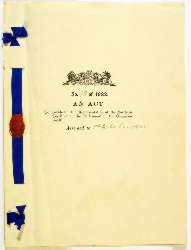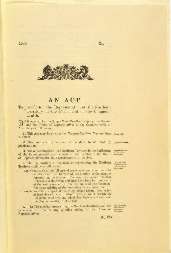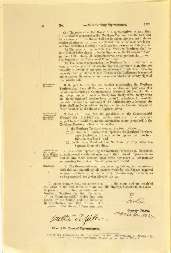

Northern Territory Representation Act 1922 (Cth)
Significance
The Governor-General assented to this Act in signing this document on 5 October 1922. A belated acknowledgment of equal rights for Territory voters, it provided them with a Member in the House of Representatives, though this was a non-voting Seat.
History
Territorians had, from 1863 until 1911, the same voting rights for representatives in both Houses of the South Australian Parliament as people living in South Australia. This status had also enabled them to qualify as South Australian voters in elections for both Houses of the Commonwealth Parliament after 1901.In 1911 the transfer of the Northern Territory to the Commonwealth government deprived Territorians of all political representation. The Commonwealth Constitution did not allow for Federal electorates to cross state borders, and national governments shied away from a hypothetical impasse where a few hundred Territory voters might some day hold the balance of power in an evenly divided Commonwealth Parliament.
In retrospect it seems amazing that an Australian government would so calmly strip such basic rights from a section of its people. Not only was this done, but the Government made clear the colonial status of the Northern Territory by allocating its administration, along with that of Papua, to the Department of External Affairs.
This situation became a significant factor in the trades union agitation that led to the recall of the first Commonwealth-appointed Administrator, Dr John Anderson Gilruth, in 1918 and the forced exit of his three leading officials eight months later. The Australian Constitution (S.122) enables the Commonwealth Parliament to grant representation to a Territory in the Senate and the House of Representatives, and continuing political unrest eventually brought the question of Territory representation to the Parliament.
In the decade after the Commonwealth takeover the Territory's population had increased from 3031 to only 3572, so full representation was not an issue. This Act allowed Territorians one Member in the House of Representatives, but did not allow the Member to vote. The first Member of the House of Representatives for the Northern Territory was Harold Nelson, who had led the agitation which unseated the Administrator in 1918.
Possession of a 'parliamentary eunuch' failed to satisfy Territorians, but change came slowly. A short-lived division of the Territory into two administrative units from 1926 to 1931 did not alter its parliamentary position. In 1936 the Territory Member of the House of Representatives was given the right to vote on motions for the disallowance of Northern Territory Ordinances; in 1959 the vote was extended to any matter relating solely to the Northern Territory. Not till 1968 did the Territory Member of the House of Representatives receive full voting rights.
In 1975 the Territory was granted two seats in the Senate, but Territorians still have only two Members in the House of Representatives. In 1977 an amendment to Section 128 of the Australian Constitution finally entitled voters in the Australian Capital Territory and the Northern Territory to vote in referendums.
Sources
Donovan Peter, A Land Full of Possibilities: A History of South Australia's Northern Territory University of Queensland Press, Brisbane, 1981.
Heatley, Alistair, Almost Australians: The Politics of Northern Territory Self-government, Australian National University, North Australia Research Unit, Darwin, 1990.
Heatley, Alistair, The Government of the Northern Territory, University of Queensland Press, Brisbane, 1979.
Heatley, Alistair and Nicholson, Graham, Selected Constitutional Documents on the Northern Territory, Northern Territory Department of Law, Darwin, 1989.
Powell, Alan, Far Country: A Short History of the Northern Territory, Melbourne University Press, Melbourne, 1996
Description
| Long Title: | An Act to provide for the Representation of the Northern Territory in the Parliament of the Commonwealth. (No. 18 of 1922) |
| No. of pages: | 2 + cover |
| Medium: | Paper, with blue silk ribbons and red seal |
| Measurements: | 29 x 22 cm |
| Provenance: | House of Representatives |
| Features: | Signatures on p.2 |
| Location & Copyright: | National Archives of Australia |
| Reference: | NAA: A1559/1, 1922/18 |


